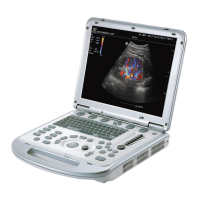5-10 Image Optimization
Gray
Rejection
This function is to reject image signals less than a certain gray scale, then
the rejected signal corresponding area turns black.
Click [Gray Rejection] in the soft menu or menu to adjust.
The adjusting range is 0-5.
Curve To manually enhance or restrain the signal in the certain scale.
Click [Curve] in the soft menu or menu to open the dialogue box to adjust.
Drag the curve node to increase or decrease the gray scale information:
drag the node up to increase the information and down to decrease.
γ The γ correction is used to correct non-linear distortion of images.
Click [γ] in the soft menu or menu to adjust.
The adjusting range is 0-3; the image turns dark when the value is
increased.
Impacts The function is available in real-time imaging, freeze or cine review status.
The post process adjustment will not influence the cine review.
High FR
Description
When the THI function is turned on, this function can provides you with
much higher frame rate.
Operation In single B mode when THI is turned on, click the [High FR] item in the soft
menu or menu to obtain images with high frame rates.
HScale
Description
Display or hide the width scale (horizontal scale).
The scale of the horizontal scale is the same as that of vertical scale
(depth), they change together in zoom mode, or when the number of the
image window changes. When image is turned up/down, the HScale will
also be inverted.
Operation Click [HScale] on the soft menu to display or hide the scale.
5.4 M Mode Image Optimization
5.4.1 M Mode Exam Protocol
1. Select a high-quality image during B mode scanning, and adjust to place the area of
interest in the center of the B mode image.
2. Press <M> on the control panel, and roll the trackball to adjust the sampling line.
3. Press <M> on the control panel again or <Update> to enter M mode, and then you
can observe the tissue motion along with anatomical images of B mode.
During the scanning process, you can also adjust the sampling line accordingly when
necessary.
4. Adjust the image parameters to obtain optimized images.
5. Perform other operations (e.g. measurement and calculation) if necessary.

